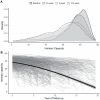Intrinsic Capacity Predicts Negative Health Outcomes in Older Adults
- PMID: 34569602
- PMCID: PMC8751795
- DOI: 10.1093/gerona/glab279
Intrinsic Capacity Predicts Negative Health Outcomes in Older Adults
Abstract
Background: Monitoring trajectories of intrinsic capacity (IC) in older adults has been suggested by the World Health Organization as a means to inform prevention to avoid or delay negative health outcomes. Due to a lack of longitudinal studies, it is currently unclear how IC changes over time and whether repeatedly measured IC predicts negative health outcomes.
Methods: Based on 4 751 repeated observations of IC (range = 0-100) during 21 years of follow-up among 754 older adults 70 and older, we assessed longitudinal trajectories of IC, and whether time-varying IC predicted the risk of chronic activities of daily living disability, long-term nursing home stay, and mortality using joint models.
Results: Average IC declined progressively from 77 to 11 points during follow-up, with substantial heterogeneity between older adults. Adjusted for sociodemographics and chronic diseases, a 1-point lower IC value was associated with a 7% increase in the risk of activities of daily living disability, a 6% increase in the risk of a nursing home stay, and a 5% increase in mortality. Accuracy for 5- and 10-year predictions based on up to 3 repeated measurements of IC ranged between moderate and good (area under the receiver operating characteristic curve = 0.76-0.82).
Conclusions: Our study indicates that IC declines progressively and that it predicts negative health outcomes among older adults. Therefore, regular monitoring of IC could work as an early warning system informing preventive efforts.
Keywords: Epidemiology; Longitudinal; Normative aging; Successful aging.
© The Author(s) 2021. Published by Oxford University Press on behalf of The Gerontological Society of America. All rights reserved. For permissions, please e-mail: journals.permissions@oup.com.
Figures



References
-
- WHO. World Report on Ageing and Health. World Health Organization; 2015.
Publication types
MeSH terms
Grants and funding
LinkOut - more resources
Full Text Sources
Medical

